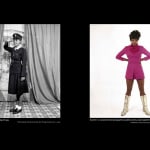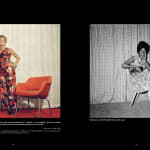





JAMES BARNOR X MAISON CF
Maison CF, 2015
Further images
- (View a larger image of thumbnail 1)

- (View a larger image of thumbnail 2)

- (View a larger image of thumbnail 3)

- (View a larger image of thumbnail 4)

- (View a larger image of thumbnail 5)

- (View a larger image of thumbnail 6)

"Born in 1929 in Accra, James Barnor is considered a pioneer of Ghanaian photography. James Barnor’s career bridges continents and photographic genres to create a transatlantic narrative marked by his passionate interest in people and cultures. Through the medium of portraiture, Barnor’s photographs represent societies in transition: Ghana moving towards its independence and London becoming a cosmopolitan, multicultural metropolis.
Along with his contemporaries in other parts of Africa – Seydou Keïta in Mali, Van Leo in Egypt or Rashid Mahdi in Sudan – Barnor started his career by opening a photographic portrait studio called « Ever Young » in Accra in the early 1950s. Barnor was well-versed in making his clients feel at ease, through vibrant conversation and a background of popular music, creating a unique bond between photographer and sitter.
During this period Barnor captured intimate moments of luminaries and key political figures, including Ghana’s first prime minister, Kwame Nkrumah as he pushed for pan-African unity. Not only was James Barnor engaged as the first photojournalist to work with the Daily Graphic – a newspaper brought to Ghana by the British media group, the Daily Mirror, he was also regularly commissioned by Drum magazine – South Africa’s influential anti-apartheid journal for lifestyle and politics – for whom he photographed several news features.
In 1959, two years after Ghana became independent from colonial rule, Barnor moved to London, then a bourgeoning multicultural European capital to deepen his photographic knowledge. There, he discovered colour photography and enrolled on a two-year course at Medway College of Art while still shooting for Drum magazine; several of his photographs were published as covers and distributed internationally.
During London’s « swinging sixties », Barnor eloquently captured the mood of the time, and the African diaspora’s experiences in the city, including BBC radio journalist Mike Eghan at Piccadilly Circus. He also photographed celebrities, such as Muhammad Ali minutes before his match against Brian London at Earl’s Court.
These years were equally punctuated by Barnor’s first encounters with a multinational cohort of aspiring models and Drum cover girls, who would later pose for him against the backdrop of the city’s most iconic monuments, thus becoming fashion icons at the meeting of cultures.
Towards the end of the decade Barnor was recruited and trained as a representative for Agfa-Gavaert, before returning to Ghana in 1969 where he opened the first colour processing laboratory and studio X23 in Accra. For the next two decades, he worked independently as well as for several government agencies in Ghana."



